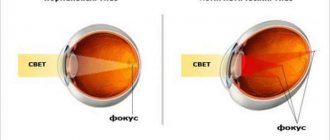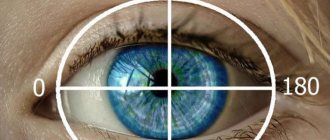- What is this and how to fix it?
- How does astigmatism manifest?
- What are the symptoms of astigmatism?
- What are the types of astigmatism?
- Is it normal to have slight astigmatism?
- What diagnostics are performed for astigmatism?
- How can astigmatism be corrected?
- What are the indications for laser vision correction?
- Surgical treatment of astigmatism
- How is the operation performed?
- What are the possible contraindications?
- What to do if laser methods are contraindicated?
- Cost of treatment for astigmatism
How does astigmatism manifest?
An eye without refractive error is called emmetropic. The light rays are focused at one point on the retina, creating a full-fledged, clear image.
With astigmatism, the rays cannot focus at one point on the retina; two foci are formed, which can be located at different distances, both in front and behind the retina. The combination of the location of the foci relative to the retina largely determines the classification of astigmatism. In fact, the image that forms on the retina is not the same at every point, and the object appears elongated, altered. For example, a circle will look like an ellipse. This anomaly is usually congenital and has a genetic origin. It can also occur after injury, infection, or corneal pathology such as keratoconus.
Often, astigmatism is first diagnosed during a preventive examination or at an appointment with an ophthalmologist for another eye disease, so it is important to undergo diagnostic ophthalmological examinations, starting in childhood, for timely detection and prescription of the necessary correction of astigmatism.
What are the symptoms of astigmatism?
Symptoms of astigmatism vary depending on its type, associated refractive errors and the age of the patient. If the astigmatism is mild, then the patient has no obvious complaints, especially before the age of 25-30, although astigmatism may go unnoticed even at a later age.
The higher the degree of astigmatism, the more the patient perceives the image as blurred, altered or double. This does not depend on the distance of the object being viewed, nor on the involvement of accommodation in trying to obtain the clearest possible image.
If astigmatism is associated with hypermetropia, then when working near the patient may experience eye fatigue, redness, dizziness or headache and other asthenopic complaints.
Typical complaints of patients with astigmatism:
- Blurredness and doubling of objects located both near and far;
- Excessively rapid eye fatigue;
- Possible headache with visual strain;
- Relative improvement of the image at a certain head rotation;
- Redness of the eyes;
- Eye irritation;
- Squinting your eyes to see the image more clearly;
- Decreased vision at night.
What are the types of astigmatism?
Astigmatism can be:
- simple - emmetropia is diagnosed in one of the meridians, and hypermetropia or myopia in the other;
- mixed - characterized by manifestations of myopia in one meridian, and hypermetropia in the other;
- complex - hypermetropia or myopia of varying degrees is diagnosed in both meridians.
According to the mechanism of occurrence, astigmatism is divided into:
- congenital;
- acquired.
In some cases, the cause of astigmatism may be associated not only with abnormalities of the cornea, but also with abnormalities of the lens, and there may also be distortion of perceived objects due to pathology of the central zone of the retina, which must be taken into account during the diagnostic examination of the patient.
Therefore, according to the location they are distinguished:
- Corneal astigmatism (most common);
- Lens astigmatism.
Is it normal to have slight astigmatism?
There are no patients with a perfectly spherical cornea; the presence of a certain degree of astigmatism is physiological. This form of astigmatism is present in the patient throughout his life, but the patient never feels it. This astigmatism is usually up to 0.5 diopters and does not need to be corrected with glasses or contact lenses.
Previously, you can take a rapid test to detect astigmatism >>
Astigmatism with cataracts
If patients with corneal astigmatism develop age-related cataracts, lens replacement surgery can simultaneously correct the corneal astigmatism. In such cases, an artificial toric lens is chosen.
Dr. Belikova's eye clinic specializes in conservative correction of astigmatism in children and laser correction of astigmatism in adults. Experienced doctors with many years of expertise in the diagnosis and treatment of ophthalmological diseases of varying levels of complexity are always waiting for you here.
What diagnostics are performed for astigmatism?
Diagnosis of astigmatism is carried out during an ophthalmological examination with the obligatory determination of visual acuity without correction and under conditions of optimal correction. There are many ways to diagnose astigmatism:
- The Snellen chart is used to test visual acuity;
- Optotypes for determining astigmatism;
- The autorefractokeratometer allows you to measure the optical power of the eye and the astigmatic component;
- Biometer is an optical device for measuring various structures of the eyeball, including indicating the presence of astigmatism;
- Keratotopograph is a device capable of accurately measuring the parameters of the cornea at each point on both the front and back surfaces, which is a unique diagnostic criterion;
- Keratometer , used to measure the curvature of the cornea;
- A subjective refractive test is necessary to obtain proper confirmation of astigmatism;
- Optical coherence tomography of the cornea.
Clinics for laser vision correction for astigmatism
To combat astigmatism, patients who resort to laser correction mainly choose specialized clinics
. Most often, medical tourists go for treatment to Turkish, Korean and German hospitals. These include:
Batygoz Ophthalmological Center
Read about the clinic →
Hangil Eye Clinic
Read about the clinic →
Spreebogen Ophthalmology Center
Read about the clinic →
Dunyagöz Ophthalmology Center
Read about the clinic →
APPOINTMENT AT THE CLINIC
MediGlobus specialists will help you choose an ophthalmology center and contact its representatives as soon as possible. We will choose the best option for you.
How can astigmatism be corrected?
The most effective methods for correcting astigmatism are:
- Temporary or reversible correction of astigmatism (spectacle or contact correction),
- Permanent (surgical).
The last category includes various methods of excimer laser refractive surgery, including femto-assisted surgery (PRK, LASIK, REIK, FEMTO LASIK).
If it is impossible to use laser operations, implantation of toric phakic lenses or implantation of intraocular toric lenses is performed. Thanks to these innovative methods, it is possible to change the shape of the cornea and correct not only astigmatism, but also other associated visual impairments (myopia, hypermetropia). During a diagnostic examination, our ophthalmologist will determine individually which method of astigmatism correction is most suitable for each patient.
What is temporary correction of astigmatism?
Astigmatism can be corrected temporarily or permanently. Temporary correction of astigmatism involves the use of contact lenses or glasses. The optical design of a spectacle glass or contact lens allows you to take into account all the nuances of the redistribution of diopters along various meridians. However, spectacle and contact correction of astigmatism have both their positive aspects and disadvantages. Wearing glasses or contact lenses often causes discomfort and headaches - the eyes quickly get tired or cannot adapt to the new correction at all.
Glasses are absolutely indispensable for the patient and give him the opportunity to have good vision, but over time they can become uncomfortable, annoying for those who have to use them daily and depend on them.
Contact lenses are more convenient, but also have a lot of disadvantages and, in addition, can lead to pathology of the cornea, conjunctiva, eyelids, and cause dry eye syndrome. However, today you can take a different path and restore your vision using laser vision correction surgery and forget about addiction and poor vision forever.
What is permanent astigmatism correction?
Astigmatism can be permanently corrected, thereby ensuring the patient's visual acuity remains consistently high. Intervention for the final correction of astigmatism is performed using PRK, LASIK, REIK, FEMTO LASIK techniques and is recommended for those who have any degree of astigmatism, as well as any other visual anomalies.
For the final permanent correction of astigmatism (and any other associated visual defects) in our clinic, ophthalmic surgeons use the best surgical and laser equipment of the latest generation, high-tech techniques and safe, uniquely accurate femtosecond and excimer lasers.
The combination of two advantages - the best equipment and highly qualified surgeons - undoubtedly gives an excellent result: high visual functions and improved quality of life.
Laser treatment of astigmatism is indicated for patients with refractive disorders of the optical functions of the eye. It is correction using a laser beam that allows you to eliminate all visual optical disturbances and return good vision to the patient.
What are the indications for laser vision correction?
Laser correction or correction of astigmatism is indicated:
- patients with astigmatism up to 6 diopters;
- patients with vision problems aged 18 to 50 years;
- patients with intolerance to spectacle correction;
- patients at risk of developing dry eye syndrome who use contact lenses;
- professional athletes or people who work in certain areas that require high-precision vision without the possibility of using temporary correction devices;
- patients with anisometropia.
In the above situations, laser treatment of astigmatism will be effective and will help the cornea acquire the correct spherical shape, eliminating the manifestations of astigmatism and obtaining high visual acuity, which will significantly improve the quality of life.
It is important to know! Taking into account the peculiarities of the development of the optical system of the eye in children, correction of astigmatism is carried out only for certain indications, exclusively by ophthalmologists specializing in working with children.
Femtosecond laser correction (ReLEx Smile)
ReLEx Smile is a method of laser vision correction that does not require displacement of the corneal epithelium and is performed through a much smaller incision on its surface. Indications for such an operation include both myopia (up to 10 diopters) and myopic astigmatism (up to 5 diopters).
The following are considered contraindications:
- irregular astigmatism;
- progression of myopia over the past year;
- chronic eye diseases;
- keratoconus;
- suspicion of glaucoma;
- increased intraocular pressure.
Just like any of the listed methods of laser vision correction, the femtosecond method has many possible complications. However, today this method is recognized as the least traumatic to the eye.
Surgical treatment of astigmatism
What techniques are used for surgical correction of astigmatism?
In our Clinic we use modern, safe, high-precision methods for correcting astigmatism such as LASIK, REIK, FEMTO LASIK, FEMTO REIK, FEMTO SUPERLASIK, FEMTO SUPERREIK.
All these techniques are based on the principle of intrastromal refractive surgery and consist in forming a flap from a thin surface layer of the cornea and further processing the layers of the cornea with a laser beam.
LASIK technique
LASIK correction is a reliable, effective and affordable way to restore quality of vision to patients. During surgery, the ophthalmologist creates a flap, then the corneal stroma is ablated with a laser beam.
REIC methodology
Correction using the REIC method is an innovative development of doctors at Dr. Kurenkov’s Clinic. It consists of eliminating refractive errors with high precision using an excimer laser.
After changing the shape of the cornea and returning the flap to its place, the eyes are treated with saline, which avoids contamination and deformation.
FEMTO REIC
With the FEMTO REIC technique, flap formation with the highest possible precision is performed using a femtosecond laser, which eliminates the use of a blade, providing access to the stromal layer of the cornea without any contact inside the cornea, on which it is necessary to perform photoablation with an excimer laser. Accuracy, smoothness and evenness (including the formed corneal bed) ensure the best result of the operation.
What are the advantages of the FEMTO REIC technique?
The FEMTO REIC technique has a lot of advantages, both objective and subjective. Here are some of them:
- it is a particularly safe and extremely precise operation thanks to the use of a femtosecond laser;
- this is a painless intervention: a few drops of anesthetic action are enough to undergo the operation calmly and painlessly;
- the risks in the intraoperative and postoperative period are further reduced. Complications are kept to a minimum, also thanks to the high level of sterility guaranteed by the laser beam;
- the operation does not involve the use of blades or scalpels - therefore, there is no contact impact and inaccuracies;
- Postoperative recovery is faster than with other surgical methods.
This technology has the following advantages:
- safety and painlessness of correction;
- lack of postoperative dressing;
- the ability to predict the result before surgery;
- stability of the result obtained;
- preservation of the anatomical features of the outer shell of the eye;
- possibility of performing correction on both eyes at once.
What is astigmatism?
Mikhail Konovalov explains: “The eye is structured like a camera - it also consists of several lenses. One of the main lenses is the cornea - this is the superficial part of the eye, the transparent tissue. The cornea refracts rays, which then fall on the retina. Ideally, the cornea should be spherical, like a dome, and symmetrical. The vertical and horizontal axes of the cornea should be the same. If the cornea has an irregular shape, then eye astigmatism occurs - a phenomenon when one axis refracts light more strongly and the other weaker, so the beam of light hitting the retina is blurry. This defect can be corrected using: special cylindrical lenses, contact lenses or surgery. With the help of surgery, we make the cornea the way it should be - spherical. This is most often accomplished through refractive surgery using an excimer laser.”
Astigmatism. The program “Live Healthy”, says Prof. Konovalov
Release of the program “Live Healthy” dated September 15, 2010. (about astigmatism from 32 minutes of video)
How is the operation performed?
Laser correction of astigmatism consists of three stages:
- A flap is formed on the cornea and placed to the side.
- Using a laser, part of the cornea is evaporated, giving it the correct shape, which can significantly improve the patient’s vision.
- After giving the cornea a spherical shape, the previously folded flap of tissue is returned to its place and tightly fixed without treating it with suture material, which can significantly speed up regeneration after the intervention.
Laser surgery for astigmatism in both eyes takes 10 to 12 minutes. The intervention is performed under local anesthesia and does not cause discomfort. Vision is restored a few hours after the operation, and regeneration takes only a few days, without requiring the patient to stay in the hospital.
Progress of the operation
Stages of laser correction for astigmatism:
- A person sits on a couch.
- Drops with an analgesic effect are instilled.
- An eyelid speculum is installed.
- A special ring is introduced to determine the center.
- A flap is formed to allow laser treatment of the cornea.
- Correction is performed using the selected technology.
- The corneal flap is returned to its place and, if necessary, fixed with a lens.
- The operated organ is treated with anti-inflammatory drugs.
It is advisable that a relative meet the person after treatment and help escort him home.











